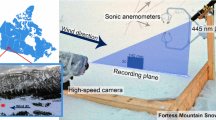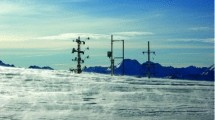Abstract
This paper presents a new triple-moment blowing snow model PIEKTUK-T by including predictive equations for three moments of the gamma size distribution. Specifically, predictive equations for the total number concentration, total mass mixing ratio, and total radar reflectivity for blowing snow are included. Tests in the context of idealized experiments and observed case studies demonstrate that the triple-moment model performs better than the double-moment model PIEKTUK-D in predicting the evolution of the number concentration, mixing ratio, shape parameter, and visibility in blowing snow, provided that the fall velocities for the total number concentration, mass mixing ratio, and radar reflectivity are weighted by the same order of the respective moments in both models. The power law relationship between the radar reflectivity factor and particle extinction coefficient found in PIEKTUK-T is consistent with one observed in snow storms. Coupling of the triple-moment blowing snow model to an atmospheric model would allow realistic studies of the effect of blowing snow on weather and climate.
Similar content being viewed by others
References
Bintanja R (2000). Snowdrift suspension and atmospheric turbulence. Part I: Theoretical background and model description. Boundary-Layer Meteorol 95: 343–368
Bintanja R (2000). Snowdrift suspension and atmospheric turbulence. Part II: Results of model imulations. Boundary-Layer Meteorol 95: 369–395
Budd WF (1966). The drifting of non-uniform snow particles. In: Rubin, MJ (eds) Studies in Antarctic meteorology Antarctic Research Series, vol 9, pp 59–70. American Geophysical Union, Washington DC
Budd WF, Dingle WRJ and Radok U (1966). The Byrd snow drift project: outline and basic results. In: Rubin, MJ (eds) Studies in Antarctic meteorology Antarctic Research Series, vol 9, pp 71–134. American Geophysical Union, Washington DC
Déry SJ and Yau MK (1999). A bulk blowing snow model. Boundary-Layer Meteorol 93: 237–251
Déry SJ and Yau MK (2001). Simulation of blowing snow in the Canadian arctic using a double-moment model. Boundary-Layer Meteorol 99: 297–316
Déry SJ and Yau MK (2002). Large-scale mass balance effects of blowing snow and surface sublimation. J Geophy Res 107(D23): 4679 Doi:10.1029/2001JD001251
Déry SJ, Taylor PA and Xiao J (1998). The thermodynamic effects of sublimating, blowing snow in the atmospheric boundary layer. Boundary-Layer Meteorol 89: 251–283
Dixon M, Rasmussen RM, Landolt S (2004) Short-term forecasting of airport surface visibility using radar and ASOS. In: 11th conference on aviation, range, and aerospace, Hyannis, MA, 4–7 Oct 2004
Dover SE (1993) Numerical modelling of blowing snow. Dissertation, University of Leeds
Garratt JR (1992). The atmospheric boundary layer. Cambridge University Press, Cambridge, 316 pp
Harrington JY, Meyers MP, Walko RL and Cotton WR (1995). Parameterization of ice crystal conversion process due to vapor deposition for mesoscale models using double-moment basis functions Part I: Basic formulation and parcel model results. J Atmos Sci 52: 4344–4366
King JC (1989). Low-level wind profiles at an Antarctic coastal station. Antarctic Sci 1: 169–178
Kobayashi D (1972). Studies of snow transport in low-level drifting snow. Contributions from the institute for low temperature Science 24: 1–58
Mann GW (1998) Surface heat and water vapor budgets over Antarctica. Dissertation, University of Leeds
Mann GW, Anderson PS and Mobbs SD (2000). Profile measurement of blowing snow at Halley, Antarctica. J Geophy Res 105: 24491–24508
Middleton WEK (1952). Vision through the atmosphere. University of Toronto Press, Toronto
Milbrandt J and Yau MK (2005). A multi-moment bulk microphysics parameterization. Part I: Analysis of the role of the spectral shape parameter. J Atmos Sci 62: 3051–3064
Muench HS, Brown HA (1977) Measurement of visibility and radar reflectivity during snowstorms in the AFGL Mesonet. Project 8628, Met Division, Air Force Geophysics Laboratory, Hanscom AFB, Massachusetts, AGFL-TR-77–0148
Pomeroy JW (1988) Wind transport of snow. Dissertation, University of Saskatchewan
Pomeroy JW and Male DH (1988). Optical properties of blowing snow. J Glaciol 34(116): 3–9
Pomeroy JW, Gray DM and Landine PG (1993). The prairie blowing snow model: characteristics, validation, operation. J Hydrol 144: 165–192
Pomeroy JW, Marsh P and Gray DM (1997). Application of a distributed blowing snow model to the Arctic. Hydrol Proc 11: 1451–1464
Schmidt RA (1982). Vertical profiles of wind speed, snow concentrations and humidity in blowing snow. Boundary-Layer Meteorol 23: 223–246
Sommerfeld R and Businger JA (1965). Density profile of blown snow. J Geophy Res 70: 3303–3306
Thorpe AD and Mason BJ (1966). The evaporation of ice spheres and ice crystals. Br J Appl Phys 17: 541–548
Xiao J, Bintanja R, Déry SJ, Mann GW and Taylor PA (2000). An intercomparison among four models of blowing snow. Boundary-Layer Meteorol 97: 109–135
Author information
Authors and Affiliations
Corresponding author
Rights and permissions
About this article
Cite this article
Yang, J., Yau, M.K. A New Triple-Moment Blowing Snow Model. Boundary-Layer Meteorol 126, 137–155 (2008). https://doi.org/10.1007/s10546-007-9215-4
Received:
Accepted:
Published:
Issue Date:
DOI: https://doi.org/10.1007/s10546-007-9215-4




